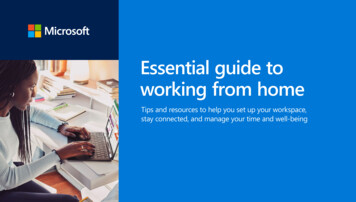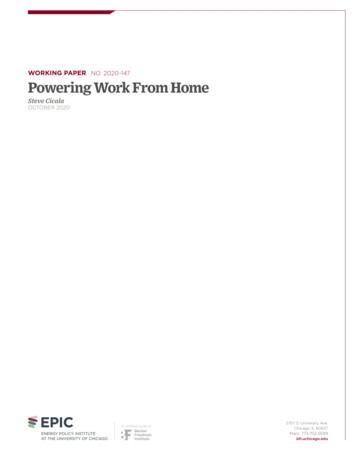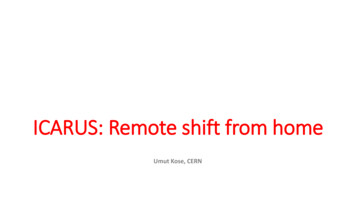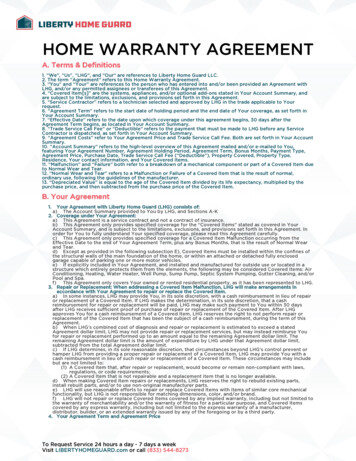
Transcription
TheWorkingFrom HomeHandbook
Table of Contents3Introduction:Embrace the New Normal5You’re in Good Company7Dress Your Desk (and Yourself)for Success1013The Long-distance Relationship:Communication is KeyWhat’s in Your Toolbox?16Process and Performance:Holding Yourself Accountable19Keeping the “Social” inSocial Distancing21Work/Life Balance:The Art of Self-care23Brought to You bySkillsoft and SumTotal
Introduction:Embrace theNew NormalThe future of work is already here. In the midst of aglobal pandemic, many companies are shifting to afully remote workforce – joining, as Time magazine putsit, “The World’s Largest Work-From-Home Experiment.”But working from home during a crisis is a far cry fromphoning it in from a lush tropical isle 3
What does itall mean for you?Here at Skillsoft, we’re dedicated tohelping you be your best – wherever yourdesk happens to be. We’ve compiled thisguide to help you navigate the comingchallenges, achieve a better work-lifebalance, and show up confidently foryour team every day.4
You’re inGood CompanyStudies show remote work makes employees feelhappier, less stressed, and better able to achievework-life balance. (Some of today’s workers are eveninclined to take a pay cut to benefit from the addedflexibility.) Working from home is economical.Just consider the savings when your commute ismeasured in footsteps rather than miles, and yourmorning latte is home-brewed.5
GreenBonus:4.7 million US employees work remotely at least 50% of the time.From financial perks to the happiness factor, the stats are impressive:A half-time telecommuter saves the equivalent of11 workdaysHalf-time remote workerscould reduce greenhousegas emissions by 54 millionper year.tons every year – the(GlobalWorkplaceAnalytics.com)equivalent to taking theentire New York StateThe average employee saves betweenworkforce off the road!(GlobalWorkplaceAnalytics.com)Remote workers earnsalaries higher than 2,500 and 4,000 per yearby working at home just half the time.(GlobalWorkplaceAnalytics.com) 100,000per yearRemote workers say they’re happy in their jobs2.2x more frequentlythan on-site workers.than on-site workers.(OwlLabs)29% more(OwlLabs)6
Dress Your Desk(and Yourself)for SuccessHere’s some advice: keep your workspace separate, andyour living space sacred. Not as easy to do if your current“office” is a corner of your kitchen counter and your kids arehaving a meltdown. That being said, the advice still holds.And it all begins with mapping out a place to work.7
Bringnatureindoors.Studies suggest thatadding plants toworkspaces can lead to a60% reduction in stresslevels, and actually helpclean the air.Choose your workspace with care.Designate a space for work that feels right. Ideally, choosea spot with relative privacy and free of major distractions.Make sure it’s clean, organized, well lit, and stocked withyour work essentials – laptop, notebook, pens, pencils,calendar, healthy snacks, your lucky paperweight –whatever you need to trigger your own internal “it’s timeto work” response.Ditch the PJs.While it might be tempting to revisit the 90s grungelook, resist the urge. Dress in comfortable but workappropriate clothes that make you feel good aboutyourself. You’ll thank us when that unexpected video callpops up (and your boss will, too). A good rule of thumb?If you’re virtually meeting customers, dress as you would inperson to convey your professionalism.8
Tip: Shorton spaceat home?Get creative.Establish regular working hours.This may feel challenging at first, especially if your team isin catch-up mode. Pitch in to get things done, then decideon your availability, clear it with your supervisor, andcommunicate it to your colleagues. Establish your peakperformance times, take actual rest and lunch breaks, andTransform a closet intoa “cloffice,” find your Zenwith a cushion and a coffeetable, clear off a floatingshelf and pull up a chair.Even an ironing board canbe a makeshift desk.“turn off” and exit your workspace at the end of your day.Need some time management tips? Check out this video.And, take our advice: never, never work in bed.During times of stress and disruption, quality sleep is veryimportant. That blue light emitted by your tech screenshas been shown to suppress the production of melatonin,the hormone that controls your sleep/wake cycle.9
The Long-distanceRelationship:CommunicationIs KeyFrom shaking hands to holding doors, non-verbalcues and body language during physical meetingsengender trust and enhance understanding.10
When you’re working from home, it’s easy to feel disconnected or isolated. The key?The basics of Being a Good Team Member still apply. The rules of engagementjust need to be adapted to online interactions.According to highlights from an MIT Sloan Management Review survey of virtualteams, following these simple suggestions can help:1Match the technology to the task.Establish best practices.Know when to use chat, email, phone, or video conferencing. Your boss may chooseto create a simple team charter that describes how you will work together. Then, writea personal tech checklist to make sure you’re up to speed and connected.2Make your intentions clear.Context and clarity matter.Review written messages before sending them to make sure you have struck theright tone and use emojis to minimize negative interpretation. Emphasize importantinformation, highlight priorities, and use “response requested” in the subject line.Err on the side of over-clarification, take notes, and keep a record of conversations.11
3Stay in sync.Out of sight, not out of mind.Maintain regular communication with team members. Acknowledge importantmessages, even if immediate action isn’t possible. Seek clarification to betterunderstand others’ intentions before jumping to conclusions.4Be responsive and supportive.Build trust early.Respond promptly to requests from coworkers and take the time to providesubstantive feedback. Suggest solutions to problems the team is facing and maintaina positive and supportive tone in communications.5Be open and inclusive.Learn from each other.Dispersed teams are more likely to have members from different cultures andbackgrounds. Accentuate the positive aspects of diversity and recognize the richopportunities in working together.Check out this video for more great tips for effective communication.12
What’s inYour Toolbox?The first step in determining which platformto use is understanding the differencebetween synchronous and asynchronouscommunication.13
Synchronous communication:Participants are communicating simultaneously.Response is immediate.Examples: Audio and video conferencing,instant messagingAsynchronous communication:Participants are not communicating simultaneously.Response can be delayed.Examples: Sending email, using projectmanagement softwareSuccessful remote teams use a blend of the two depending on their needs.Too much synchronous communication can lead to constant interruptions,which can harm productivity and lead to professional – and personal – burnout.Too little, and you risk losing the personal connection that builds trust and makeswork feel more worthwhile.Thankfully, there’s a rich bank of technologies today that can help get your teamon the same page, boost collaboration, and increase productivity. Many popularapps are multi-functional, offering both synchronous and asynchronouscommunication capabilities.14
Some of the most popularremote communication tools include:SlackBasecampWidely used, great features, integrates withGoogle Docs and Dropbox. Slack-averse?Check out Ryver, Glip, Twist, Fleep, and Flock.Premier resource for remote work, user-friendly,“The All-In-One Toolkit for Working Remotely.”Microsoft TeamsSeamless integration with Office 365.Offering a free version in the effort to connectfolks during a crisis.Google HangoutsIntegrates with G-Suite or third-party callingapps, offers livestreams.TrelloFun, flexible, fresh collaboration capabilitieswith built-in workflow automation.AsanaSimple to use, great reporting and feedbackcapabilities. No-charge data storage.WebexGreat video conferencing features, cloudcalling, and first-class tech support.ZoomVideo first, unified communications platform,offers a free basic plan for small businesses.Need to sharpen your skills? Skillsoft’s Productivityand Collaboration Tools Collection provides trainingfor the applications, operating systems, and devicesmost used by today’s organizations. Try it free!15
Process andPerformance:Holding YourselfAccountableThere are countless online resources for remotemanagers on how to effectively guide, evaluate,and improve their team’s performance.(Hint: for a good example, check this out.)16
As an employee working from home, you are essentially your own supervisor.The best remote workers are self-motivated and good at time management.Not everyone finds this easy at first. But with a shift in perspective, a littlepractice, and some helpful organizational tips, you can add a whole new skillsetto your resume.Start with a self-evaluation.An honest self-evaluation is more than a tool for reflection; it’s an opportunityfor you to recognize your accomplishments and acknowledge areas forimprovement. Remember, there’s a reason you were hired for the job you do.Lead with your strengths and a healthy sense of pride will follow.Write your mission statement.Define what professional and personal success mean for you. How do youintend to approach your work? How do you want to communicate? And whatlegacy would you like to leave behind? Use it as a tool for self-motivation as youtransition into new challenges.Your “To-Do List” is your new boss.Working from home, you’re shifting between three modes of behavior:“Personal, Supervisor, and Worker” modes. Keeping performance top of mind,organize your day according to the best times for all three. Concentrate tasks17
from each mode together, so that a larger portionof your workday can be dedicated to collaborationand deep work. For greater productivity, your dayshould begin and end with self-care. Then letsupervisory tasks bracket your workday.Invest in organizational software.Sticky notes are great visual cues, and there’s areason your CEO still uses a yellow legal pad. Butwhen you’re going all-out remote, it helps to keepyour to-do list organized in an app that syncs acrossyour devices. Some highly rated choices includeToDoist, Any.do, and Microsoft To Do. If your creativity flourishes best with penin hand, give your notes an upgrade and choose a smart notebook that lets youswitch between platforms.Set up regular check-ins with your boss.Before you log-on or pick up the phone, be prepared. Write a list of what you’dlike to cover, and always lead with positives. Share project status, clarify yourgoals, and ask for guidance and input. As in office one-on-ones, be sensitive totime constraints, and always begin and end conversations with courtesy.18
Keeping the“Social” in SocialDistancingAcross multiple studies, loneliness is cited as a majorchallenge faced by virtual employees. With the currentsocial distancing recommendations added to the mix,“remote” work has never felt more aptly named. Whilethere’s no one-size-fits-all solution, connecting on apersonal level throughout the workday can go a longway toward camaraderie.19
Try these simple suggestions:During daily “stand-ups,” stand upand be counted.If your boss holds morning check-ins, she maychoose to start with an ice breaker. Follow her lead,get involved in the conversation, and put a positivespin on your contribution. That way, your day isalready off to a good start.Unexpectedremote workbenefit:You may find that the lackof on-site “office drama”can actually lead to moremeaningful relationships.Drop by the virtual water cooler.Many virtual teams have learned to shift informal chatter to a dedicatedmessaging channel. While participating is usually optional, it’s a great way to getto know your colleagues better, foster friendships, and share ideas.Reach out and dine in.If you’re missing dim sum with your office chum,schedule a virtual lunch date. Reconnect overdelivery (or even a PB&J). Invite the kids to thetable, or introduce the dog(s). Is your teamonboarding a new recruit? Bonus points forinviting the new kid on the block to join you.20
Work/Life Balance:The Art of Self-careIn today’s uber-connected world, there’s alwaysone more email to answer or one more hour tolog. Ignoring the need to rest and recharge canbe disastrous to your work and health, not tomention your relationships.Here are some ideas to help you set reasonableboundaries.21
Sleep is not a luxury.Studies show nearly half of employees who always work from home reportsuffering from insomnia. One of the culprits appears to be our smartphonesand laptops – their blue light can trick your body into thinking it’s daytime.Make your bed a no-tech zone and let the snooze cycle begin.Start and end your day with exercise.Use that saved commuting time well. Get in that extra half-hour of shut-eye,and then get moving. Gym closed? Go for a brisk walk and take in the sun.Or check out online training apps and join a virtual class. Use movement as abridge between work hours and personal hours – your body will register theswitch, easing you out of work time and into “you time.”Take mini-meditation breaks.Working from home can lead to bad habits like “stress-snacking.” If you findyourself reaching for the donuts, find a quiet spot, grab your headphones, andtry a meditation app instead.When your workday ends, shut it down, turn it off, and make time for yourself,your friends, and your family. Then bring that peace of mind to your workthe next day.22
Brought to Youby Skillsoftand SumTotalWhile we’re working together to flatten thecurve, there’s bound to be a learning curve, too.We hope this handbook has inspired you, andhelped you find useful tools during thischallenging time.23 page
Lead with your strengths and a healthy sense of pride will follow. Write your mission statement. Define what professional and personal success mean for you. How do you intend to approach your work? How do you want to communicate? And what legacy would you like to leave behind? Use it as a tool for self-motivation as you transition into new challenges. Your “To-Do List” is your new boss .











